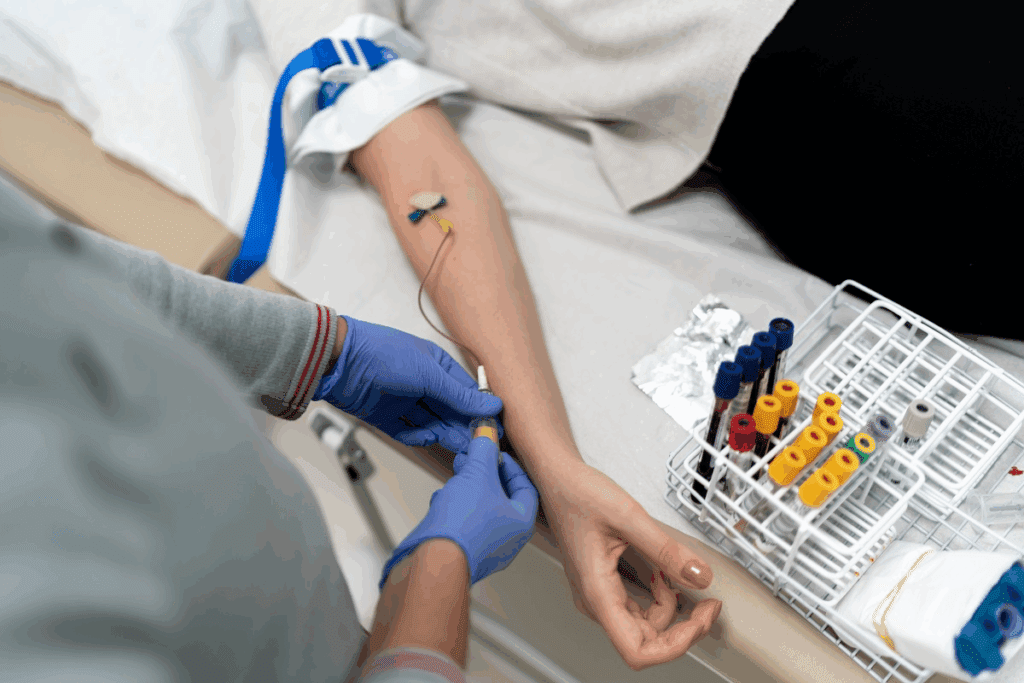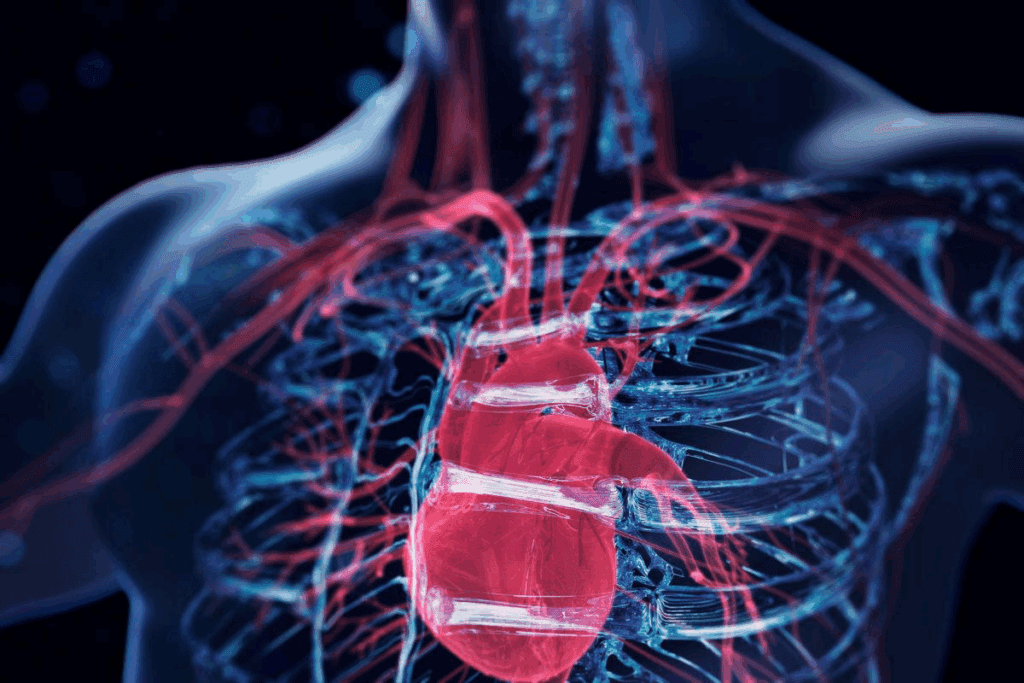Last Updated on November 25, 2025 by Ugurkan Demir
When the heart beats too quickly, it can be a sign of a serious condition. Atrial tachycardia (AT) and supraventricular tachycardia (SVT) are two types of arrhythmias that start above the ventricles.
At Liv Hospital, we know how important it is to tell these conditions apart. Both can cause palpitations and discomfort. But they have different causes, symptoms, and treatments.
We will look at the main differences between AT and SVT. This includes their causes, symptoms, and how to treat them. Knowing these differences is key to managing and treating them well.


To grasp the details of atrial tachycardia and supraventricular tachycardia, we must first learn about cardiac arrhythmias. These occur when the heart’s electrical signals go awry, leading to irregular heartbeats.
Learn 7 key differences and treatments between atrial tachycardia vs supraventricular tachycardia.
The heart’s electrical system is a complex network that manages our heartbeat. It starts with the sinoatrial (SA) node, our heart’s natural pacemaker. It sends out electrical impulses.
These impulses then travel through the atrioventricular (AV) node and down the bundle of His. They eventually reach the ventricles, making them contract.
Tachyarrhythmias happen when the heart beats over 100 times per minute. They can be caused by many things, like abnormal electrical pathways in the heart. Tachyarrhythmias come in different types, depending on where they start and how they work.
| Type of Tachyarrhythmia | Description | Common Causes |
| Atrial Tachycardia | Originates in the atria | Abnormal automaticity, triggered activity |
| Supraventricular Tachycardia | Involves the atria or AV node | Reentrant circuits, abnormal automaticity |
Knowing these basics is key to diagnosing and treating cardiac arrhythmias well. As we dive into atrial tachycardia and supraventricular tachycardia, we’ll look at their unique traits and differences.

Atrial tachycardia is a heart rhythm disorder. It causes a fast heart rate from the atria. Knowing its definition, causes, and types is key.
Atrial tachycardia happens when the atria beat too fast. It can be caused by heart disease, imbalances in electrolytes, or drugs. The heart’s electrical system gets out of sync.
Mechanism of Atrial Tachycardia: It can be due to the heart cells beating too much or a loop of electrical activity. This loop keeps the heart racing.
“Atrial tachycardia is a complex arrhythmia that can be challenging to diagnose and manage due to its various underlying mechanisms and presentations.”
Cardiology Expert
There are different types of atrial tachycardia. They vary in how long they last and how they start and stop.
| Type | Duration | Characteristics |
| Paroxysmal | Seconds to hours | Starts and stops abruptly |
| Persistent | Longer duration | Requires medical intervention |
| Incessant | Continuous or long periods | Rare, often challenging to manage |
Treating atrial tachycardia depends on the cause, symptoms, and the patient. Knowing the types and how they work is important for treatment.
Supraventricular tachycardia, or SVT, refers to abnormal heart rhythms that start above the ventricles. It’s a complex condition with different forms, each needing its own treatment.
SVT is marked by a fast heart rate from the atria or the AV junction. It’s a wide category that includes many specific arrhythmias. Knowing the type is key to managing it well.
SVT includes AVNRT, AVRT, and atrial tachycardia (AT). Let’s look at these closely.
AVNRT has a reentrant circuit in the AV node. AVRT involves an extra electrical pathway. Both have similar symptoms but need different treatments.
AT is a type of SVT but not all SVTs are AT. AT starts in the atria, while other SVTs might involve the AV node or extra pathways. Knowing these differences helps in diagnosing and treating.
Healthcare providers can improve patient care by understanding these differences. They can then tailor treatments to the specific SVT type, leading to better outcomes.
Atrial tachycardia and supraventricular tachycardia are related but different. They affect how we care for patients. We need to understand their differences and how they are classified.
Supraventricular tachycardia (SVT) includes heart rhythms that start above the ventricles. Atrial tachycardia (AT) is a type of SVT. It has a fast heart rate that starts in the atria.
The hierarchy is simple:
| Category | Description | Examples |
| Supraventricular Tachycardia (SVT) | Tachyarrhythmias originating above the ventricles | Atrial Tachycardia, AVNRT, AVRT |
| Atrial Tachycardia (AT) | A subtype of SVT originating from a specific atrial focus | Focal Atrial Tachycardia, Multifocal Atrial Tachycardia |
The difference between AT and other SVTs is key. Their treatments vary. AT might need a unique approach for both immediate and long-term care.
Clinical Implications:
By knowing AT’s unique traits, doctors can tailor care. This improves patient outcomes.
The main difference between atrial tachycardia and supraventricular tachycardia lies in their origin and pathways. Knowing these differences is key for correct diagnosis and treatment.
Atrial tachycardia (AT) starts from abnormal electrical sources in the atria. These sources can be anywhere in the atrial tissue, causing fast heartbeats. The pathways in AT mainly stay within the atrial chambers.
Supraventricular tachycardia (SVT) covers a wide range of fast heart rhythms starting above the ventricles. It includes mechanisms like atrioventricular nodal reentrant tachycardia (AVNRT) and atrioventricular reentrant tachycardia (AVRT). These often involve complex circuits in both atrial and ventricular tissues.
The origin and pathways of AT and SVT greatly affect treatment choices. Knowing where a tachycardia starts is vital for picking the right treatment.
For example, treatments targeting specific areas might work better for AT. SVT might need treatments that tackle the complex circuits. This shows how important accurate diagnosis is for managing these heart issues.
It’s key to know how Atrial Tachycardia (AT) and Supraventricular Tachycardia (SVT) work. Their unique ways of working affect how they show up in patients.
Atrial Tachycardia mainly comes from two causes: enhanced automaticity and triggered activity. Enhanced automaticity means the heart beats too fast because of faulty ion channels or heart disease. Triggered activity happens when the heart gets extra signals during or after it relaxes. These signals can cause early heartbeats and keep AT going.
Supraventricular Tachycardia often has reentrant circuits. This means an electrical signal keeps going round and round, making the heart race fast. This loop can go through different paths, like the AV node or extra pathways. SVT can also be caused by the heart beating too fast on its own or by extra signals, just like AT. But, the loop is a big part of SVT’s problem.
The way AT or SVT works affects how they show up in patients. For example, AT from beating too fast might start and stop slowly. SVT with loops might start and stop quickly. Knowing how they work helps doctors choose the best treatment.
Knowing the difference between these mechanisms is important for patient care. Doctors can make treatment plans that fit each patient better. This can lead to better results for everyone.
The electrocardiogram (ECG) is key in spotting the unique signs of Atrial Tachycardia and Supraventricular Tachycardia. It’s vital for diagnosing and telling these arrhythmias apart.
In Atrial Tachycardia, the P wave looks different from a normal heartbeat. The P wave’s shape and direction can hint at where the tachycardia starts. For example, a P wave with a unique direction might show an abnormal heartbeat source. “The P wave shape can tell us a lot about the tachycardia’s cause,” say heart experts.
Supraventricular Tachycardia has many types, each with its own ECG signs. For instance, AVNRT shows a narrow QRS complex and no P waves. AVRT, on the other hand, has a narrow QRS complex with P waves after the QRS. Knowing these signs is key for correct diagnosis.
Spotting these signs needs a deep understanding of the underlying causes. As one study found, “The ECG is essential for diagnosing SVT, giving us important clues about the arrhythmia’s cause and how it starts.”
There are more ways to look at AT and SVT beyond the basic ECG. These include:
These methods offer deeper insights into diagnosing and treating these complex heart issues. As
“Using advanced diagnostic tools with our clinical skills helps us better diagnose and treat AT and SVT.”
It’s important to know how atrial tachycardia and supraventricular tachycardia present. This knowledge helps doctors diagnose and treat these conditions. Patients often face symptoms that affect their daily life.
Atrial tachycardia (AT) can cause palpitations, chest discomfort, and dyspnea. Some people might feel fatigue or dizziness if the condition is ongoing or happens often.
The symptoms of AT can change based on the cause and the patient’s heart health. For example, paroxysmal AT might start and stop suddenly, while persistent AT can last longer.
Supraventricular tachycardia (SVT) includes various conditions, each with its own symptoms. AVNRT (Atrioventricular Nodal Reentrant Tachycardia) often starts and stops quickly. Atrial fibrillation or flutter may begin more slowly and cause palpitations and shortness of breath.
| SVT Type | Common Symptoms | Characteristics |
| AVNRT | Palpitations, dizziness | Sudden onset/offset |
| Atrial Fibrillation | Palpitations, shortness of breath | Irregularly irregular rhythm |
| Atrial Flutter | Palpitations, fatigue | Regular or irregular rhythm |
Some symptoms need immediate medical help, like severe chest pain, syncope, or severe dyspnea. These signs might mean a serious problem or a heart issue.
We must watch for these warning signs and act fast. This ensures the patient gets the right care.
AT and SVT react differently to treatments, which is important for doctors to know. The success of treatments can greatly affect how well a patient does and their quality of life.
Vagal maneuvers are often used first to stop certain tachyarrhythmias. For SVT, these maneuvers can work well, like the Valsalva maneuver or carotid massage. They can turn SVT back to a normal rhythm in many cases.
But, AT might not work as well with vagal maneuvers. This is because AT’s cause is not always tied to the AVN. Yet, some AT cases might respond to these maneuvers, if the arrhythmia is triggered or enhanced by autonomic changes.
SVT and AT react differently to antiarrhythmic drugs. Adenosine is often used for SVT because it works well on AVN-dependent circuits. But, AT might not respond as well to adenosine, as its cause is not always tied to the AVN.
For long-term treatment, both AT and SVT might need antiarrhythmic drugs. But, the right drug and how well it works can vary. For example, some class III drugs might be better for AT, while others are better for SVT.
| Arrhythmia Type | Vagal Maneuver Response | Pharmacological Response |
| AT | Variable response; less effective | May require specific antiarrhythmic drugs |
| SVT | Often effective, specially for AVN-dependent SVT | Adenosine highly effective for acute termination |
Knowing which treatment will work is key for managing AT and SVT. Things like heart disease, how long the arrhythmia lasts, and heart structure can affect treatment success.
For AT, heart disease or big atrial enlargement might mean treatments won’t work as well. In SVT, the type of SVT and if there are extra pathways can affect how well treatments like catheter ablation work.
Understanding these differences helps doctors create better treatment plans for AT and SVT patients. This can lead to better outcomes for patients.
It’s key to know how to manage Atrial Tachycardia (AT) and Supraventricular Tachycardia (SVT) quickly. The first steps in treating these heart issues can really affect how well a patient does.
For AT, the first steps usually include controlling the heart rate and rhythm. Rate control is often done with beta-blockers or calcium channel blockers. These help slow the heart rate and boost heart function. Sometimes, anti-arrhythmic medications are used to get the heart back to a normal rhythm.
| Treatment Approach | Medications/Interventions | Goals |
| Rate Control | Beta-blockers, Calcium Channel Blockers | Slow ventricular rate, improve cardiac output |
| Rhythm Control | Anti-arrhythmic medications | Restore normal sinus rhythm |
For SVT, the first step is often vagal maneuvers. If these don’t work, adenosine is used to stop the arrhythmia. If these steps don’t succeed, electrical cardioversion might be needed.
Electrical cardioversion is for patients with AT or SVT who are unstable or when other treatments don’t work. It uses an electrical shock to get the heart back to normal.
In summary, managing AT and SVT quickly needs a plan that fits each case. Knowing these differences is vital for the best care.
Managing AT and SVT long-term needs a mix of treatments. Each patient’s needs are unique.
For Atrial Tachycardia, doctors often start with medication. This includes anti-arrhythmic medications to control heart rate and rhythm.
Medicines like beta-blockers and calcium channel blockers help manage symptoms. They also prevent AT episodes.
SVT has different types, each needing its own treatment. Ablation therapy is often used for frequent or severe cases.
Some SVT types are treated with medication. Others might need more invasive methods.
Catheter ablation is a top choice for treating AT and some SVT types. It uses energy to destroy bad heart pathways.
Success rates depend on the condition and the patient’s heart anatomy.
Changing your lifestyle is key in managing AT and SVT. Avoiding triggers like caffeine and alcohol is important.
Living a healthy life, with regular exercise and a balanced diet, helps prevent episodes.
Atrial tachycardia and supraventricular tachycardia can cause serious problems if not treated. These issues can greatly affect a patient’s quality of life. They may also lead to more serious health problems and even death.
Not treating atrial tachycardia and supraventricular tachycardia can lead to many complications. These include:
The long-term outlook for atrial tachycardia versus other supraventricular tachycardias varies. It depends on the cause, heart health, and how well treatment works.
| Condition | Long-Term Outlook | Factors Influencing Prognosis |
| Atrial Tachycardia | Generally good with appropriate treatment | Underlying heart disease, response to ablation |
| AVNRT | Excellent with curative ablation | Success rate of ablation, recurrence rate |
| AVRT | Generally good, but risk of recurrence | Presence of accessory pathway, success of ablation |
Improving quality of life is key in managing atrial tachycardia and supraventricular tachycardia. Good treatment can lessen symptoms, reduce anxiety, and improve overall happiness.
We stress the need for care plans that focus on the patient’s health and lifestyle. This approach helps manage the arrhythmia and supports the patient’s well-being.
It’s important to know the difference between atrial tachycardia and supraventricular tachycardia for the right treatment. We’ve looked at how they are different, including their causes, how they work, and how they show up in tests. This helps us understand why each needs its own treatment plan.
When we compare atrial tachycardia and supraventricular tachycardia, we see big differences. These differences affect how we treat them. Knowing these differences helps us choose the best treatment for each patient.
Doctors can give better care when they know the specific traits of each condition. This leads to better health and happiness for patients. As we learn more about these heart issues, we can make care even better for those with AT and SVT.
Atrial tachycardia starts in the atria. Supraventricular tachycardia, on the other hand, includes arrhythmias from above the ventricles. This includes AVNRT and AVRT.
Paroxysmal atrial tachycardia is a sudden and brief arrhythmia. It often causes a fast heart rate.
Vagal maneuvers can stop some types of supraventricular tachycardia, like AVNRT. But they don’t work as well for atrial tachycardia.
Symptoms include palpitations, shortness of breath, and dizziness. Some people may not show any symptoms.
Doctors use an electrocardiogram (ECG) to diagnose atrial tachycardia. The ECG shows the arrhythmia’s characteristics.
Treatment may include vagal maneuvers, medications, or cardioversion. The choice depends on the case.
Some medications work for both conditions. But the treatment plan varies based on the arrhythmia type.
Catheter ablation is very effective for some supraventricular tachycardias, like AVNRT and AVRT. It’s also used for atrial tachycardia in some cases.
Making lifestyle changes can help. Avoiding triggers, staying healthy, and managing stress can reduce arrhythmia episodes.
Untreated arrhythmias can cause heart failure, stroke, and lower quality of life. Early diagnosis and treatment are key.
Subscribe to our e-newsletter to stay informed about the latest innovations in the world of health and exclusive offers!